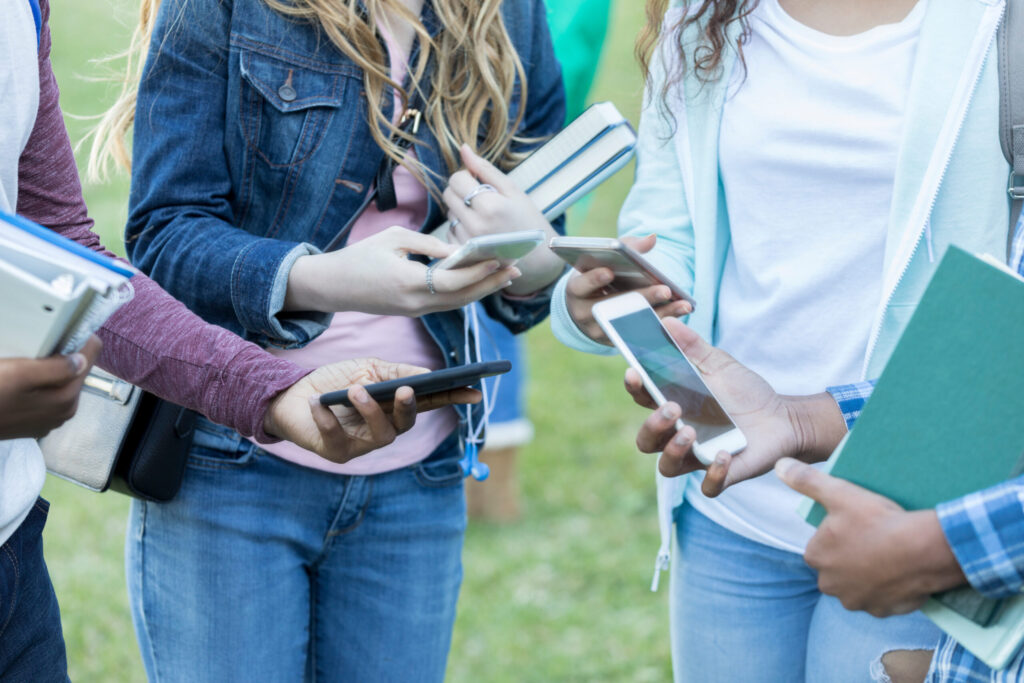A group of teenagers checking their cellphones. (Courtesy of SDI Productions via Getty Images)
The Virginia Department of Education announced on Tuesday that it has published its final cell phone-free education guidelines. Two months ago, the governor directed the department to develop them to limit students’ time using “addictive” cell phones in schools and eliminate “clear distractions” in the classroom.
Va. plans to create cell phone-free education guidelines. Developing them will be complex.
The final guidelines, which have grown from a seven-page document to 27 pages, include suggestions on improving communication gaps between parents, teachers and school officials in emergency and non-emergency situations. Additional information was added to support school leaders with the best practices.
The guidelines continue to define “cell phone-free” education as “bell-to-bell,” meaning phones should be turned off and stored away from the first school bell until dismissal. The period includes lunchtime and breaks between classes.
VDOE said many students wrote in asking to use their cell phones during lunch, but doubled down on its position that the phones distract students.
“It is essential that students have the opportunity to develop face-to-face conversations and critical in-person communication skills during unstructured school hours,” the agency stated.
The final guidelines only provide exemptions for students with disabilities and English Learner students with a documented language barrier.
According to studies, students have used cell phones to browse the internet and social media apps, and message people during instructional time. Students have also used the devices to record events at schools and post them on various platforms.
As proposed last month, the draft guidance includes age-appropriate cell phone restrictions in Virginia’s elementary and secondary public schools.
If a parent determines an elementary student needs to bring a cell phone or personal electronic communication device to school, it must be stored, off, and away from the student during the school day. Students should not use cell phones in the school building or on the school grounds before or after school.
In middle and high school, students should not have a readily available cell phone or personal electronic communication device during the bell-to-bell school day, the guidance states.
Middle schools should establish local policies that determine cell phone and personal electronic communication device use within the school building or on school grounds outside of bell-to-bell, the guidance stipulates, including before and after school.
Cell phones and personal electronic communication devices may be used on a high school campus before or after school.
Officials said Tuesday that a task force will also be established to support schools and division leaders in enhancing communications and handling school-based emergencies.
“This guidance from the Virginia Department of Education is an important step towards creating a healthier learning environment where students can receive a quality education free from harmful distractions,” said Gov. Glenn Youngkin in a statement, who thanked parents, students and school staff for their “substantive engagement” in the process and committed to continued discussions to refine the policies.
Department officials held several meetings with the public before drafting the guidelines. The public comment period ended on Sunday. While some have already adopted cell phone regulations, school boards are expected to adopt them by Jan. 1.
On Thursday, VDOE will release an “Administrator’s Toolkit” to support school leaders in implementing their policies. No timetable was provided for when the microgrants are expected to be available for schools to raise awareness about the mental health impacts of cell phones and social media.
The governor allocated $500,000 from existing funds for the Departments of Education and Behavioral Health and Development Services to support the initiative.
“We are so thankful for the collaborative input from families, educators, and students on such a critical challenge for our young people,” said Superintendent of Public Instruction Lisa Coons in a statement. “Virginians helped us shape the final guidance and our implementation supports. We look forward to continuing to work with families and educators as we help ensure that every student can have a cell phone-free education.”
GET THE MORNING HEADLINES DELIVERED TO YOUR INBOX

